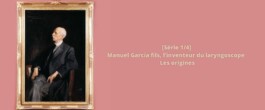


8 août 2023
En mettant en lumière l’histoire de Manuel García fils (1805-1906), le Centre Européen de Musique rend hommage à un artiste polymathe, pédagogue, chanteur, scientifique et chercheur, membre d’une saga familiale unique en son genre : la dynastie García. L’invention du laryngoscope par Manuel García fils en 1854 n’est pas le fruit du hasard, et l’acquisition par le Centre Européen de Musique de cette relique d’une valeur inestimable constitue un symbole fort incarnant pleinement les missions que le CEM s’est attribué au XXIe siècle : bâtir des ponts entre le présent et le passé ; unifier les arts, les sciences et les humanités. Découvrez le premier épisode de notre série historique, écrite par Thomas Cousin, Doctorant en histoire et en musicologie à l’Université libre de Bruxelles et Sorbonne Université. .

Manuel Vicente Patricio Rodríguez Sitches García est né à Madrid, le 17 mars 1805, de l’union du célèbre chanteur d'opéra Manuel del Pópulo Vicente Rodríguez García (1775-1832) et de sa femme, la chanteuse d’opéra et actrice, Maria Joaquina Sitches Briones (1780-1864). Le petit Manuel García n’en est pas conscient mais cette année 1805 est un tournant majeur pour l’histoire de la musique : Manuel García père, qui vient de composer son célèbre Yo che soy contrabandista, n’est certes pas encore le comte Almaviva du Barbier de Séville, qu’il crée bien plus tard, en 1816, avec son ami Gioachino Rossini. Mais déjà, le ténor andalou s’apprête à franchir les Pyrénées pour conquérir les scènes d’Europe et d’Amérique et graver à jamais le nom de García au panthéon des dynasties les plus célèbres de l’histoire de l’opéra.
Formé par son père, dès son plus jeune âge, à la méthode espagnole du chant et aux traditions vocales italiennes de l’École du Bel canto, Manuel García fils hérite d’une formation vocale d’excellence qui le prédestine à une grande carrière de chanteur d’opéra. Cette formation débutée à Naples, se poursuit en France puis en Angleterre au rythme des tournées de Manuel García père, qui publie à Paris sa célèbre Méthode de chant et fonde à Londres sa propre école. Alors que sa sœur Maria García s’initie à son tour à l’enseignement paternel, Manuel García fils poursuit sa formation musicale dans la classe d’harmonie de François-Joseph Fétis au Conservatoire de Paris. La naissance de Pauline García, en 1821, complète la lignée d’une famille de génie prédestinée à écrire l’histoire de l’opéra outre-Atlantique.
L’année 1825 constitue, à ce titre, un nouveau tournant dans la saga familiale des García. Alors que Maria fait ses débuts au King’s Theatre de Londres dans le Barbier de Séville de Rossini, l’improbable troupe familiale composée de Manuel García père et fils, de Joaquina et de Maria se produit à la fin de l’été à Manchester, avant d’embarquer à Liverpool direction New York où Manuel García père est attendu pour participer à la première saison de l’opéra italien en Amérique. La première représentation au Park Theatre de New York, le 29 novembre, marque les grands débuts de Manuel García fils sur la scène lyrique dans le Barbier de Séville, véritable marque de fabrique familiale. On compte dans l’assistance l’écrivain américain Fenimore Cooper, qui publie la même année Le dernier des Mohicans. Le 30 septembre 1826, la dernière représentation New Yorkaise des García ponctue une première saison de plus de dix mois et soixante-dix-neuf performances.
Après le succès colossal de cette première saison de l’opéra italien aux États-Unis, la troupe familiale met le cap plein sud à la conquête du Mexique, où tout reste à construire. Manuel García fils performe à plusieurs reprises des rôles de baryton et de ténor, sa mémoire exceptionnelle lui permettant d’apprendre tous les rôles d’un opéra en quelques jours pour pallier les nombreuses lacunes et indispositions. D’autant que la troupe familiale perd Maria qui, au lendemain de son dix-huitième anniversaire, s’est mariée à New York avec un français expatrié du nom de Malibran pour échapper à l’emprise de son père. De retour en Europe au cours de l’automne 1827, Manuel García fils rejoint sa sœur à Paris. Déjà pédagogue dans l’âme, il parachève l’enseignement vocal de Maria et devient un temps son agent. Ses débuts mitigés à Naples le poussent cependant, et de manière définitive, à tirer un trait sur sa propre carrière lyrique pour se consacrer, comme son père, à l’enseignement du chant.